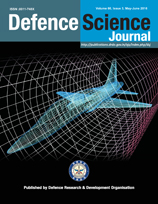Blast Valve Design and Related Studies : A Review
DOI:
https://doi.org/10.14429/dsj.66.9618Keywords:
Blast valve, wave, leakage, closure mechanism, shock tubeAbstract
The protective structures required for performing critical operations are vulnerable to the blast and shock loads of advanced weapons. A blast valve is an important component of such structures for ventilation during normal conditions and for protection from blast/ shock during explosion. In this paper, various aspects of blast valve design and related studies are briefly reviewed. The concept and effects of blast wave, blast impact, numerical modelling and deformation of circular plate (one of the critical components of blast valve) have been discussed. The merits and demerits of sensing mechanisms viz. remote and direct sensing are discussed. The leakage of blast pressure during finite closing period of the valve (one of the critical problems) and the shock tube as a major experimental facility for testing of blast valves are briefly discussed.Downloads
Published
2016-04-25
How to Cite
Sharma, P. K., Patel, B. P., & Lal, H. (2016). Blast Valve Design and Related Studies : A Review. Defence Science Journal, 66(3), 242–250. https://doi.org/10.14429/dsj.66.9618
Issue
Section
Armaments & Explosives
License
 Where otherwise noted, the Articles on this site are licensed under Creative Commons License: CC Attribution-Noncommercial-No Derivative Works 2.5 India
Where otherwise noted, the Articles on this site are licensed under Creative Commons License: CC Attribution-Noncommercial-No Derivative Works 2.5 India


